By Spencer Meagher
Having a daughter married to a Staff Sergeant in the U.S. Air Force has some unexpected benefits. I have always enjoyed visiting the various posts and bases where they are stationed — Little Rock AFB in Arkansas, Scott AFB in Mascoutah, Illinois, etc. Each has its own history proudly on display.
Four years ago, they transferred to Fort Leonard Wood (FLW), an army post located in the wooded, rolling hills of southern Missouri. This fort has a rich legacy of training soldiers dating back to World War II. FLW is also known for the engineers they’ve produced and the U.S. Army Engineer Museum located in the center of the fort. I found the history on display inside the walls of the museum very interesting, but that is a story for another day.
My focus for this article is the incredible selection of vintage and not-so-vintage military hardware that dots the roadways crisscrossing the post. The heaviest concentration is found on the rolling acreage surrounding the modern museum and the original WWII-era barracks. Flame-throwing tanks, helicopters, earth-moving tanks, portable bridges, and dozens of pieces of unknown equipment decorate the landscape.
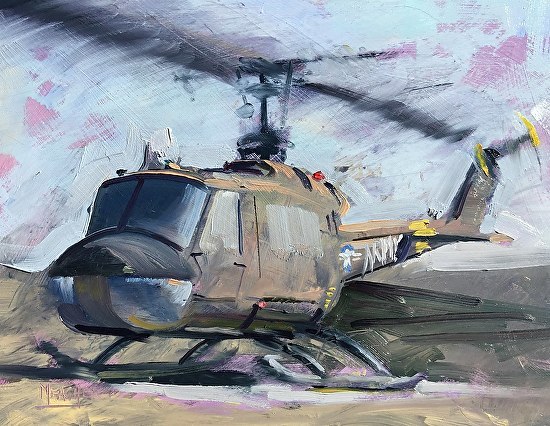
As you can see, this is fun stuff for a plein air artist to paint! Very utilitarian. No fluff. No bells. No whistles. Just the necessities. My goal was to find a way to convey to the viewer my passion for the subject. I didn’t want the finished product to be a hard-lined, stiff rendering of whatever was in front of me. I wanted to convey the mass of each vehicle in an almost romantic approach.
I’ve taken multiple workshops from cutting-edge artist Lon Brauer. Lon blurs the lines in a very literal way. He has taught me to paint juicy, i.e. utilizing lots of thinner, when appropriate. Sketch the layout. Then sand it down or “deconstruct” it to its essence. Then do it all over again while continually building on the foundation. One concept Lon stated that embedded itself in my mind was this: “When your painting becomes precious, destroy it.” Again and again, that idea came to mind as I thought that I was almost done with a painting, but something wasn’t quite right. Out would come the scraper, sandpaper, or palette knife and I’d destroy the “preciousness” of my creation.

As cool as this helicopter was in its display mode, it wasn’t enough. I felt it would be more dramatic to add some movement to the props. I went into destructive mode with rags and knives and smeared the blades, repainted them, and then destroyed again until I had what I wanted.
In each painting, I used some of Lon’s approaches and created a few of my own to break the lines and create a sense of energy and movement. That’s what being an artist is all about. Learn from others to find out who you are as an artist. I love how this painting of a Sherman tank finished out. I especially like the underpainting showing through in the shadowed area and the scrape lines that radiate out from the center of the tank.
Not enough hours in the day. I spent about six hours working on the two paintings above. As you can see in the photo above, the sun was getting low in the sky and I had to wrap it up. I was back the next morning to get one more done. The tank below.

This tank is an M60 on display along I-44 in St. Robert, Missouri, a small town near the main entrance to FLW. It sits proudly on a hill for passing motorists to see. I don’t know much about it (other than it was fun to paint). My guess is it is either from the Korean or Vietnam War. You can see it has a lower profile and a more hard-lined shape than the WWII tanks, as well as a camouflage paint scheme. Camo … another challenge. How do you represent it without painting it?
I should say that the biggest lesson learned from this exercise was learning to leave off everything that wasn’t necessary to tell the story. Not easy for me!
Three down and dozens more to go. I can’t wait to get back to FLW and paint the rest of the them!
This article was featured in PleinAir Today, a weekly e-newsletter from PleinAir magazine. To start receiving PleinAir Today for free, click here.

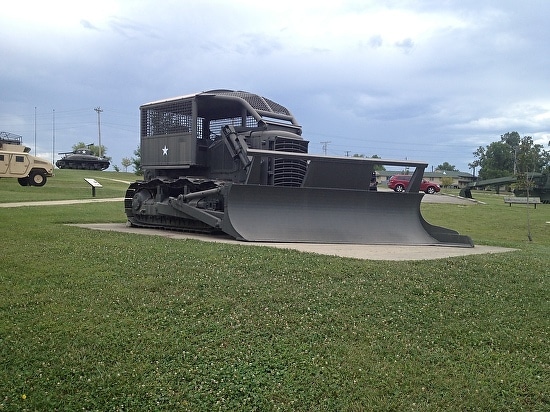
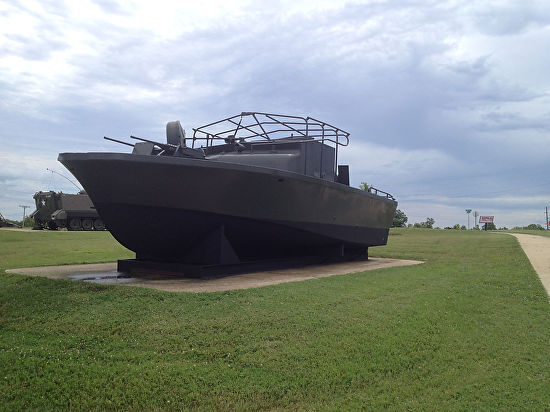
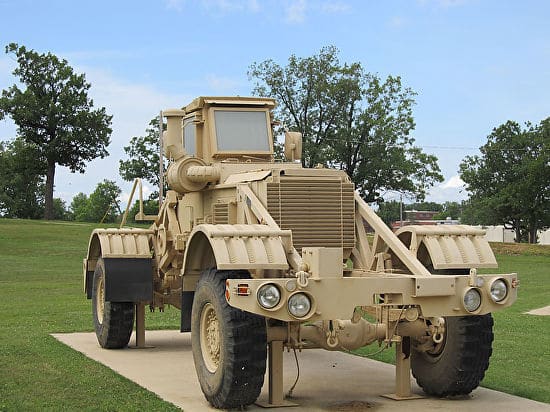
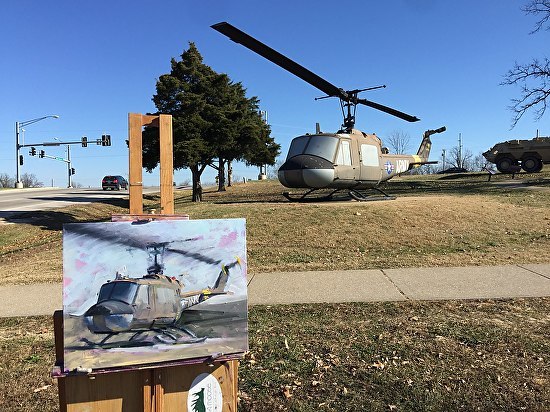
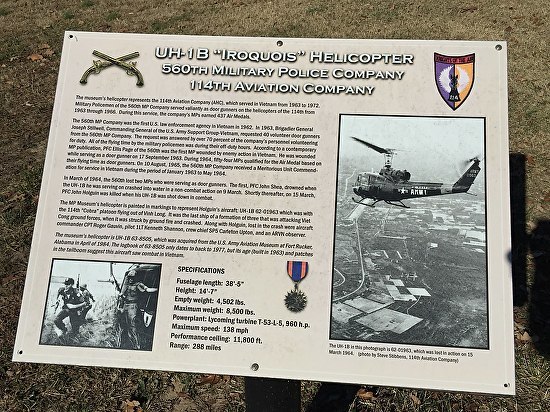
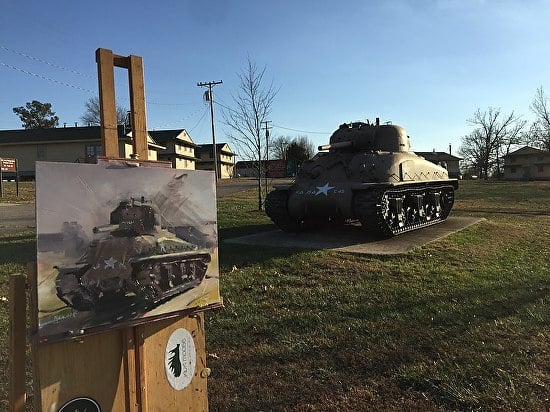
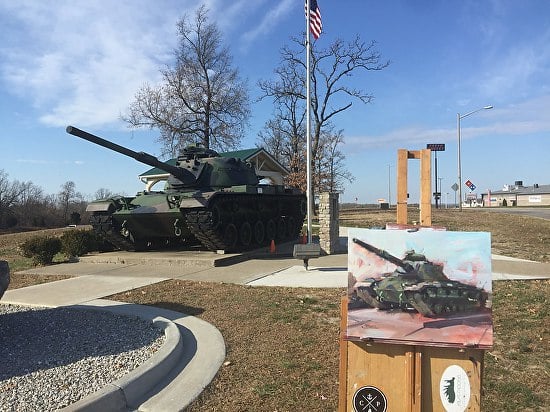
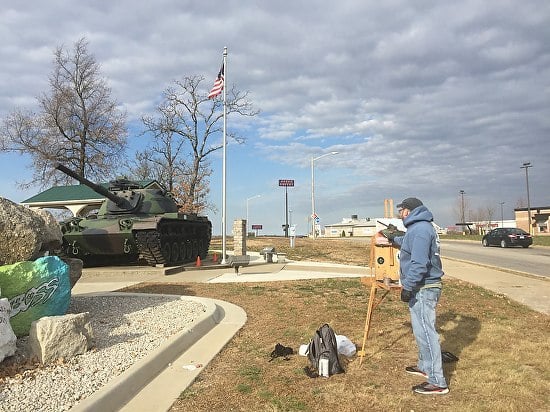



Really nice departure from typical landscapes – I enjoyed this article and your work. I had to look up the M60 – that’s a “Patton” tank, which they started making in 1960, so the monument you painted is most likely from the Vietnam war or later. You really have brought them to life in your paintings, I think you’ll find a lot of interest in the work from veterans with duties operating or maintaining them.